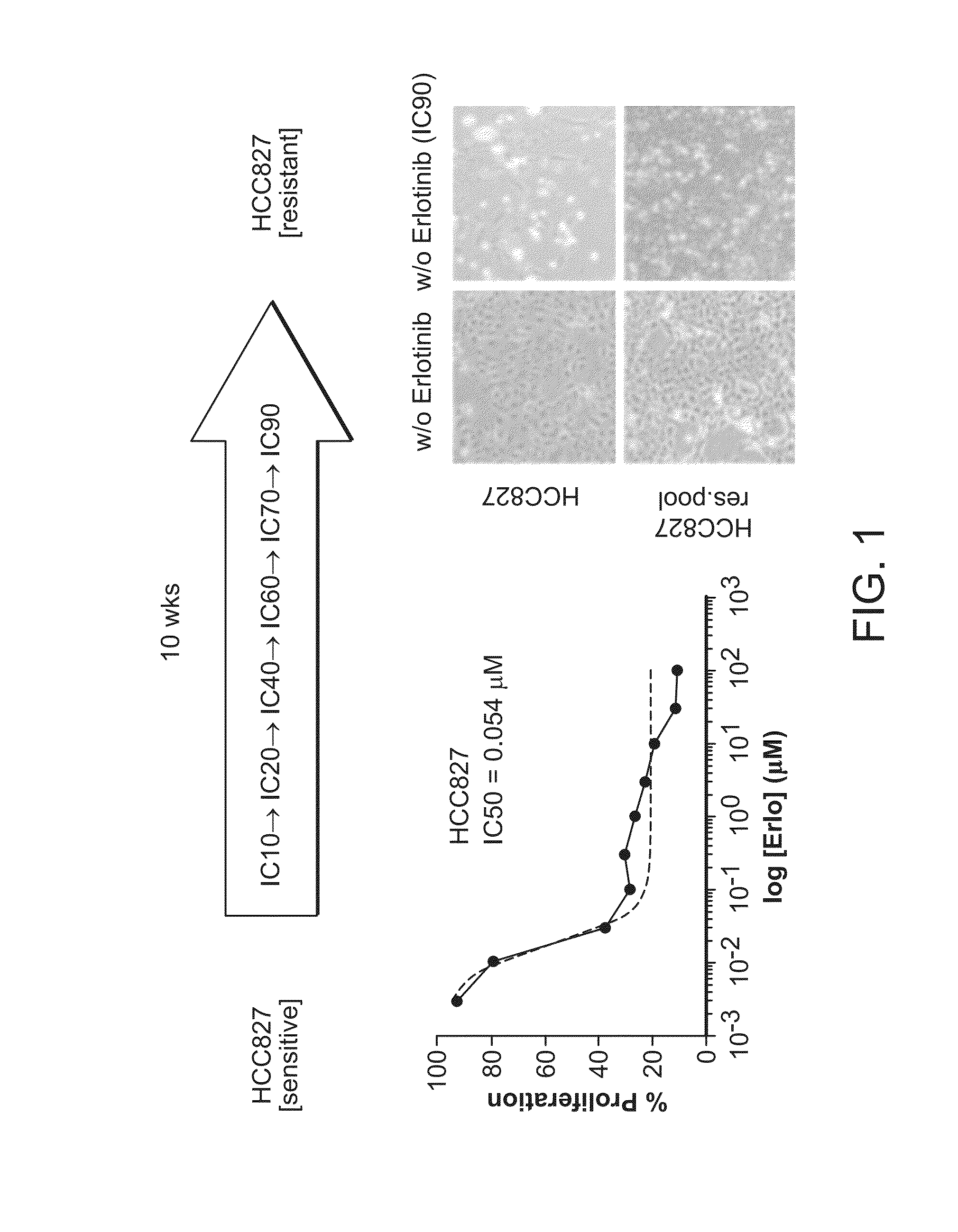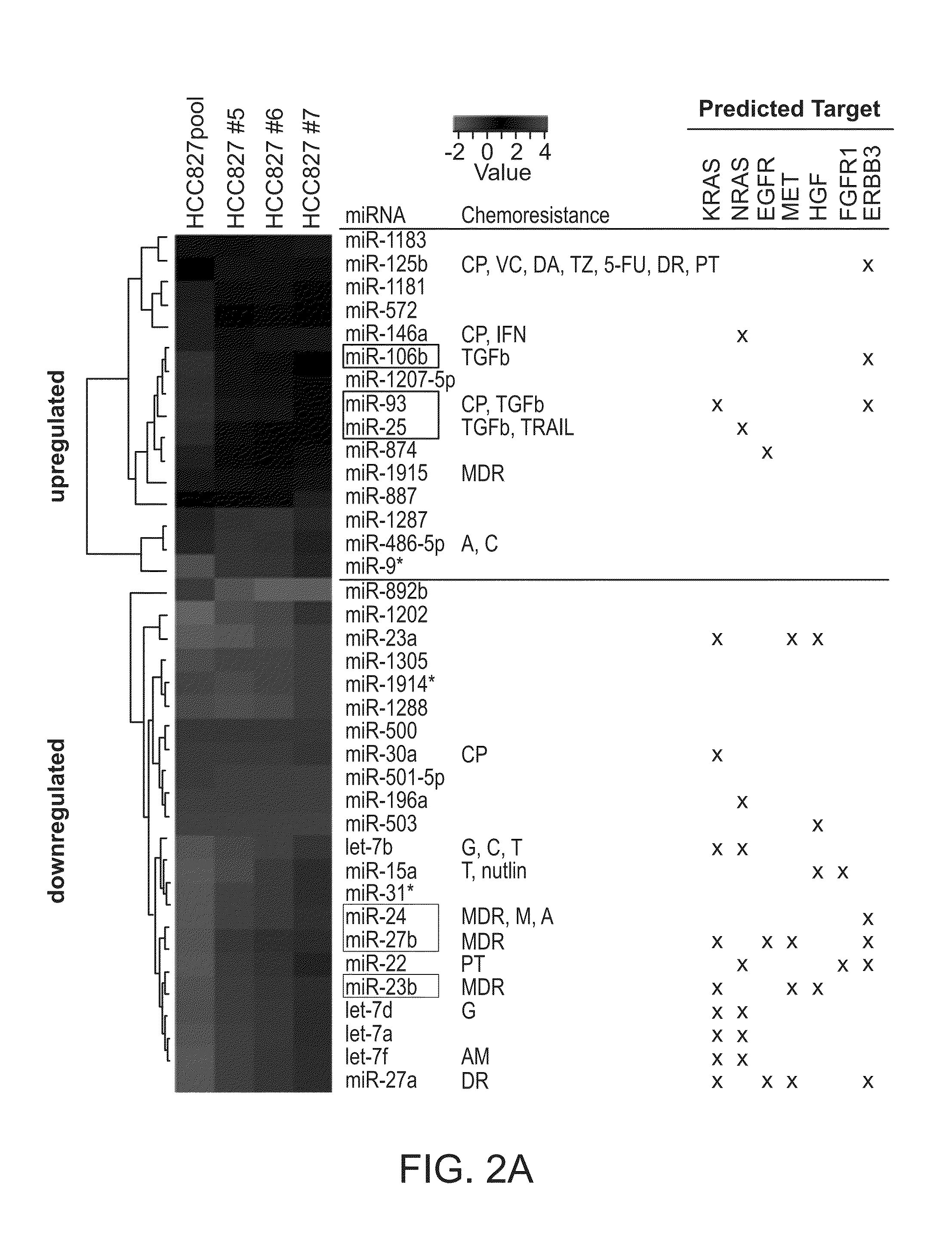Combination cancer treatments utilizing micrornas and egfr-tki inhibitors
a cancer treatment and micrornas technology, applied in the field of cancer treatment, can solve the problems of insufficient single drug combination of targeted therapies, poor survival rate of lung cancer patients, and current targeted therapies such as egfr-tkis, and achieve the effects of reducing the proliferation rate of cells, and reducing the number of cancer cells
- Summary
- Abstract
- Description
- Claims
- Application Information
AI Technical Summary
Benefits of technology
Problems solved by technology
Method used
Image
Examples
example 1
Selection of Erlotinib-Resistant Cell Lines
[0082]We followed a protocol described in Engelman et al. (supra) to generate NSCLC lines with acquired resistance to erlotinib. Briefly, parental HCC827 cells highly sensitive to erlotinib (IC50erlo=0.054 μM) were incubated with erlotinib at increasing concentrations over 10 weeks until cells were able to proliferate in medium containing erlotinib at a concentration that is equivalent to IC90 in parental HCC827 cells. Over the course of the selection, 3 cell lines from individual cell clones were obtained (HCC827clone 5,6,7). In addition, we obtained a heterogenic mass culture presumably originating from multiple clones (HCC827res.pool) (see FIG. 1).
[0083]Table 3 provides the list of 4 NSCLC cells used to assess the combinatorial effects of miRNAs and EGFR-TKIs. The particular cell lines were selected based on the IC50 values of EGFR-TKIs in these cells, their oncogenic properties and their susceptibility to miRNAs. This list includes cell...
example 2
Identification of Differentially Expressed microRNA Candidates Controlling Erlotinib Resistance
[0084]All four cell lines, as well as the parental HCC827 line were used for RNA extraction and subjected to mRNA (Affymetrix HG-U133 Plus 2.0) and miRNA (Agilent / Sanger12—0) array analysis. Unexpectedly, relatively few mRNAs were differentially expressed between resistant and parental lines (data not shown). In contrast, expression levels of miRNAs were significantly altered. A comparison of miRNA expression between the resistant cells and the parental line showed that clone #7 is most closely related to HCC827 (R2=0.9347), and the resistant pool is the least related line (R2=0.8308). This is in accord with the hypothesis that the pool arose from multiple clones. Unsupervised clustering of miRNAs identified 15 upregulated and 23 down-regulated miRNAs across all resistant HCC827 cells when compared to the parental line (FIG. 2A) miRNAs that are encoded in a gene cluster and expressed as po...
example 3
Combinatorial Effect of Erlotinib and microRNAs
[0085]Lung carcinoma cell lines used in the combination studies included cell lines resistant (H1299, H460, HCC827, all resistant) or sensitive (HCC827 parental) to erlotinib. The main aim of the combination was to achieve an enhanced therapeutic effect of erlotinib (decreased IC50) and to reduce the dose and toxicity of erlotinib. The evaluation of the combinatorial work was performed following the “Fixed Concentration Model” (Fiebig, H. H., Combination Studies). The cytotoxic compound A (erlotinib) is tested at 7-8 concentrations, and compound B (miRNA) at one weak concentration. Drug or miRNA effects on cellular proliferation were assessed using AlamarBlue assay (Invitrogen, Carlsbad, Calif.). IC50 values of erlotinib alone and in the combinations were calculated using the GraphPad software.
[0086]First, IC50 values of erlotinib alone or miRNAs alone were determined in the cells. miRNAs were reverse transfected at fixed, weak concentr...
PUM
| Property | Measurement | Unit |
|---|---|---|
| Fraction | aaaaa | aaaaa |
| Electrical resistance | aaaaa | aaaaa |
Abstract
Description
Claims
Application Information
 Login to View More
Login to View More - R&D
- Intellectual Property
- Life Sciences
- Materials
- Tech Scout
- Unparalleled Data Quality
- Higher Quality Content
- 60% Fewer Hallucinations
Browse by: Latest US Patents, China's latest patents, Technical Efficacy Thesaurus, Application Domain, Technology Topic, Popular Technical Reports.
© 2025 PatSnap. All rights reserved.Legal|Privacy policy|Modern Slavery Act Transparency Statement|Sitemap|About US| Contact US: help@patsnap.com



